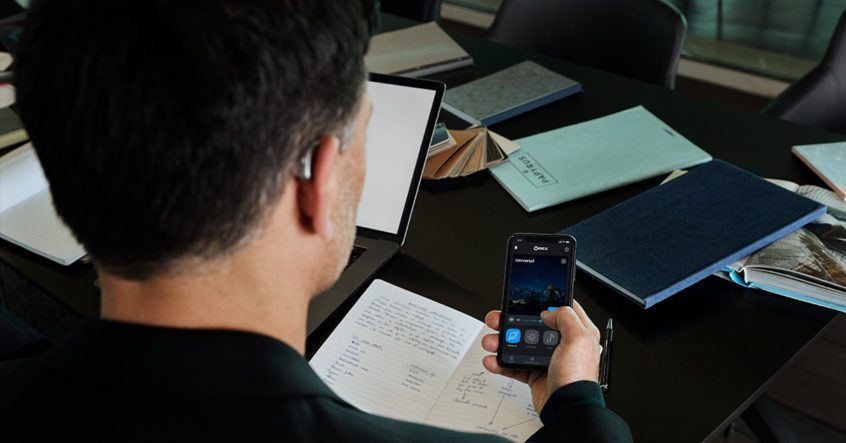If the COVID-19 pandemic has taught us anything, it’s that being able to communicate well with the people you’re in close contact with is more important than ever! Many of us are now working from home, as well as living with close circles of family and friends.
One feature many people have found helpful during this time is Bluetooth connectivity. Though Bluetooth is common in newer hearing aids, older devices typically didn’t include it. So if your hearing aids don’t have Bluetooth connectivity, or if you are looking at investing in hearing aids for the first time, here’s some information about why you should consider this important feature, especially now.
What Is Bluetooth?
The original purpose of Bluetooth technology was to help us get rid of all the cables connected from our computer to our keyboard, mouse, and monitor. That’s why instead of relying on cables, one Bluetooth-equipped device can send a wireless signal to another Bluetooth-equipped device, and the signal can be interpreted immediately. This gives the user acceptable functionality without having to worry about plugging in all their devices or fighting with a twisted tangle of wires and cables.
How Bluetooth Technology Works
Bluetooth technology was designed to be used for short distances. For example, many Bluetooth devices have a range of about 30 to 40 feet. In some cases, you can get Bluetooth devices that have a range of up to 100 feet. When you use a Bluetooth device, it transfers information into a coded signal and broadcasts it out to other Bluetooth-enabled devices within range. The other devices can then pick up on the signal.
Bluetooth Hearing Aid Technology
Today, many electronic devices are Bluetooth-enabled, like cell phones, computers, headphones, speakers, keyboards, printers, computer mice and new vehicles.
Having hearing aids that are Bluetooth-compatible allows you to connect with specific Bluetooth-enabled devices, such as your smartphone. In fact, Bluetooth technology has made it possible for your cell phone to ring and for you to hear directly through your hearing aid(s). This allows for convenient communication, as well as hearing in both ears, which results in a much clearer signal than when using a phone on one ear.
Some hearing aid manufacturers now have hearing aids that utilize Bluetooth technology compatible with Apple and Android phones. The more sophisticated hearing aids have a streamer built in, so no additional devices, streamers or wires are necessary in order to connect from your hearing aids to other devices, like your phone. All you have to do is pair the devices if they are compatible.
Streamers Link Hearing Aids and Bluetooth Devices
For those whose hearing aids do not have Bluetooth capability, compatible assistive listening devices, usually called streamers, can provide a communication link between the wireless technology in the hearing aids and Bluetooth-enabled devices.
All that’s required is for you to pair the hearing aids with the streamer, and the streamer with another external device, say a smartphone. Once this connection is established, the streamer can pick up the Bluetooth signal from the phone, sending it to the hearing aids via a digital signal or electromagnetic field. The streamer is usually worn around the neck, or placed in a pocket for hands-free operation. In addition, you can pair several devices to one streamer, like your cell phones and your iPad. If you receive a call while listening to a podcast, for example, the streamer can pause the audio so you can receive the incoming call.
If you’re uncomfortable with learning the new technology or have questions about how this technology may help you, the doctoral-level audiologists at Associated Audiologists will help walk you through the initial set-up and will show you how to pair your new hearing aids with other Bluetooth-enabled devices.
Most top hearing aid brands offer Bluetooth connectivity. Here are some pros and cons of three:
- Widex Moment and Evoke Made-for-iPhone hearing aids offer wireless connectivity with iPhones and Apple devices. The Widex Moment and Evoke app let you set up and manage your Bluetooth connections with your iPhone. For its other hearing aids and non-Apple Bluetooth connectivity, Widex offers a range of streaming accessories. Firmware updates in the near future will allow Widex Moment Bluetooth compatibility with some Android phones.
- The Phonak Audéo Marvel Bluetooth hearing aid is the only hearing aid model currently offering 100% universal wireless Bluetooth connectivity. Marvel does not require an intermediary streamer. However, these hearing aids can only connect to one Bluetooth device at a time. This means you’ll need to unpair your phone every time you want to connect to another Bluetooth device.
- GN ReSound’s current lineup of Apple-compatible models includes ReSound LiNX Quattro, ReSound LiNX 3D, and ReSound ENZO hearing aids. And ReSound is partnering with Google to develop more universal Bluetooth connectivity, starting with protocols for Made-for-Android hearing aids. For other Bluetooth devices, ReSound also offers a variety of accessories that connect its hearing aids with high-quality audio.
To learn more about Bluetooth hearing aid options and how this technology can improve your listening enjoyment, schedule an appointment with a doctoral-level audiologist.



